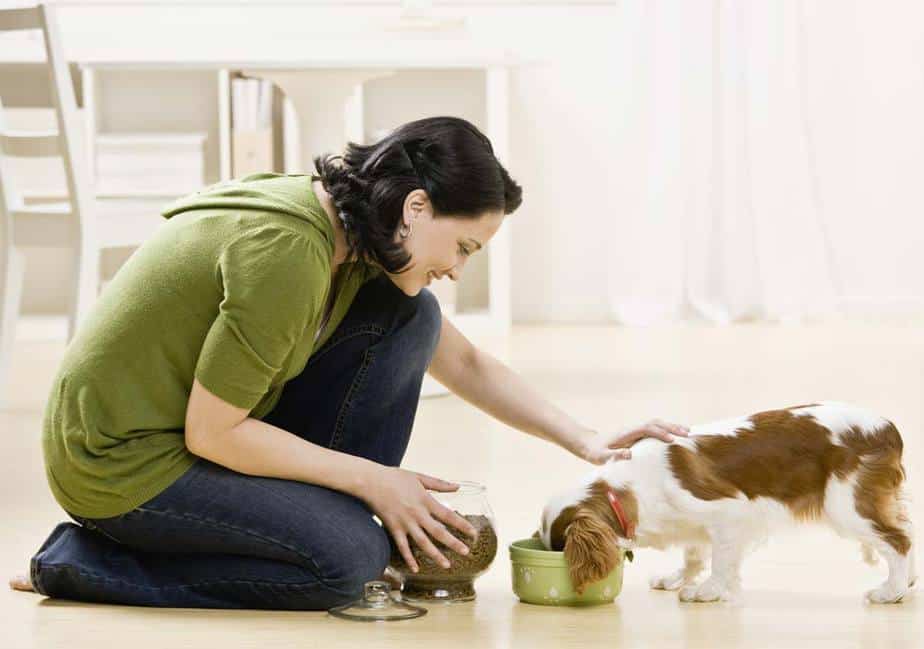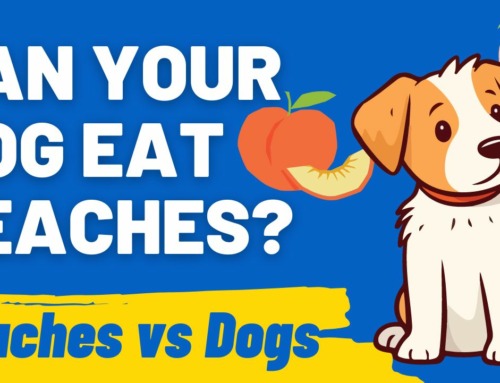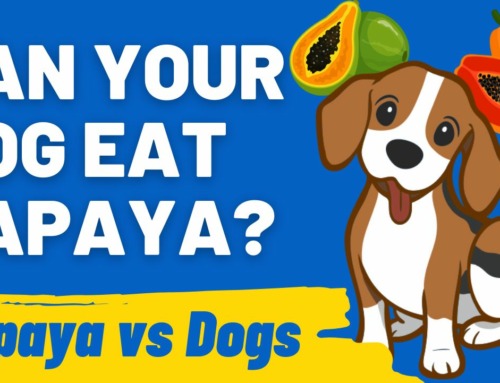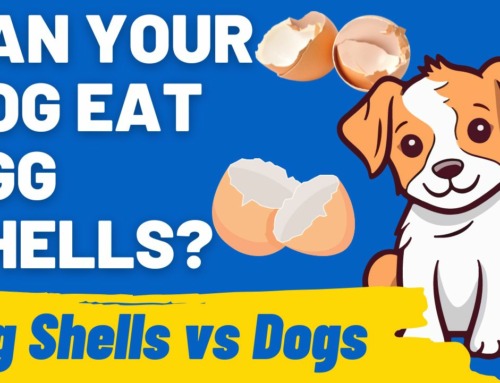Feeding kibble to your puppy is the most convenient form of dog food available, and a quality brand will offer all the nutrients they’ll ever need. In fact, many dogs will eat the same kibble happily for their entire lives.
For us humans it’s an easy choice. It doesn’t go bad, it’s more economical on the bank balance, it’s good for their teeth, and for the most part it’s less messy. So what do you do when your puppy refuses to eat it?
Why Your Puppy Won’t Eat Kibble
Puppies won’t eat kibble if they have an allergy, medical issue, dental issue, or if they’ve inadvertently been trained not to eat it. It could also simply be a plain dislike for the flavor of the kibble.
Puppies won’t eat kibble if they’ve been offered other choices in the past. Especially if they have refused to eat kibble and they’ve been given something else instead.
This can happen when you as an owner think your puppy should have eaten their kibble but haven’t. And so you find something else to try. This will inevitably train them to not eat kibble and wait for the other thing that they find preferable.
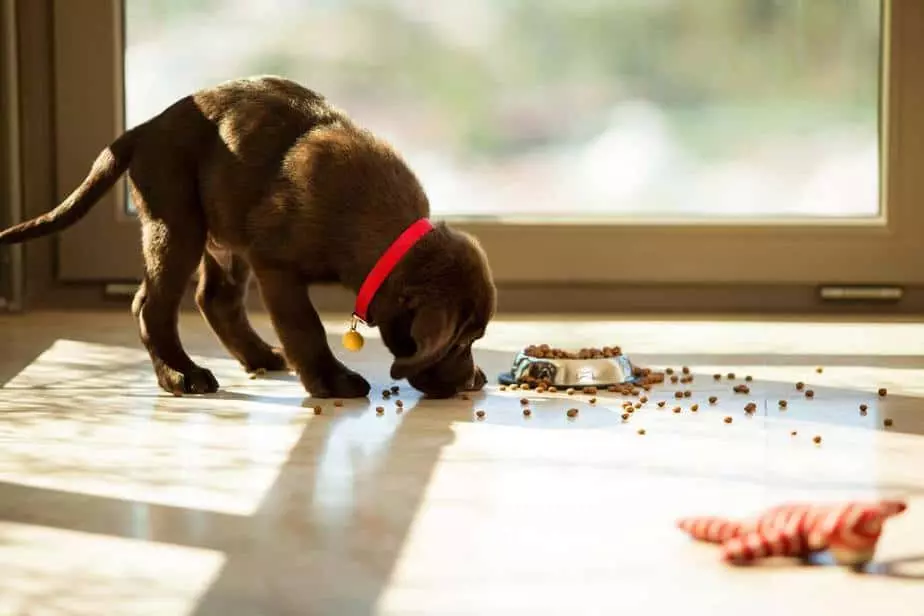
How To Get Your Puppy Eating Kibble
First things first, make sure it’s nothing medical or dental related. In this post, we’re going to stay away from getting deep into allergies and abscesses and parasites. All these things can cause eating issues with your puppy.
The truth is all these things are best determined by your puppy’s vet. If your puppy is suddenly not eating as much as usual, or has a sudden loss of appetite, then you should take them for a check-up.
It could be your puppy just doesn’t like kibble. If you do want your dog eating kibble and they don’t find it enticing, then adding some excitement to meal times can help a lot.
We have a snuffle and lick mat combo which is a great way to add foraging into meal times:
Our Method to Get Your Puppy Eating Kibble
We’re going to give you a solid plan of action to get your puppy eating kibble. One that will be sure to work! If you have access to a printer, print this blog post out so you can use it as a reference.
But first, make sure your puppy is ready to eat kibble. If you’re not sure they’re ready, you can check by reading this post first: When Can Puppies Eat Kibble? Answered!
- Stop giving your puppy all traces of human food. Let everyone know in the house that this is paramount to their kibble-eating success.
- Reduce the number of treats your puppy is getting in a day.
- Get your puppy some PetAg Esbilac Puppy Milk Replacer Powder. It’s a palatable recipe that contains prebiotics and probiotics, plus vitamins and minerals. It’s easily digestible and puppies love it!
(Another option is to use a wet puppy food to transition into 100% kibble)
- When you feed your puppy using the Puppy Milk Replacer, use 1-part powder to 2 parts warm water, then stir into your puppy’s kibble. Start by using 4-teaspoons of powder and 8-teaspoons of warm water and mix into their kibble.
- If they enjoy eating it, then gradually reduce the amount of milk powder in their kibble over a week period, until you’re no longer putting in the milk power.
- Another option is to go straight for some warm water to mix in with their kibble. For everything to know about soaking your puppy’s kibble, we have a post, Soaking Puppy Kibble: How, Why, and When to Stop
If this has worked, Hallelujah! Your puppy is now onto kibble. If this method hasn’t worked, then it’s time to up the ante. Read on for more options.
We also have this article which you may find helpful Do Dogs Get Bored of Their Food? Answered!
Routine for eating kibble
There’s a lot of advice about making sure your puppy has a routine for their mealtime. And there is merit to it. However, there is an opposing view, which we will get to in the next point.
If your puppy is being fussy with their kibble, then try using this routine strategy and see if it works for them:
- Set out your puppy’s food at a chosen time
- If they don’t eat it within 30-minutes, remove it
- Next meal, repeat the process
- If your puppy is looking around for other scraps, don’t give them treats or human food
- Repeat the steps until they eat their kibble
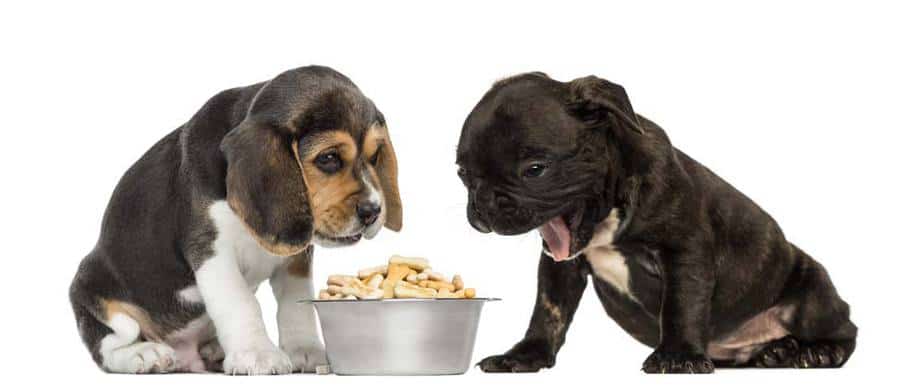
Veterinarian Comment
It is important that puppies eat several times a day. It is acceptable to feed an adult dog twice daily, however, young puppies will need to be fed at minimum three times daily. This is extremely important for small breed puppies as they are more prone to the development of hypoglycemia, or low blood sugar.
Puppies with hypoglycemia can be lethargic, cold, weak and experience seizures. Puppies exhibiting these signs should be evaluated by a vet as soon as possible. The risk of hypoglycemia is greater in small/toy breed puppies, and the risk lessens as the dog matures.
Dr Marti Dudley
No routine might get them eating kibble
Whilst the routine method can work, there is another way. Your puppy will find it difficult to stand still and eat an entire meal. That’s because puppies have a terrible case of shiny object syndrome.
Anything can distract them at a moment’s notice, and even spending time for an entire meal can be difficult for them. If this seems to be the case for your puppy then try the no routine method.
Instead of having a routine, give your puppy their daily kibble feed in a bowl and leaving it out for them.
Be sure to place it in a thoroughfare, somewhere your puppy travels often. Along with not giving your puppy any other options, and having them walk past their kibble, there’ll be a good chance they’ll go to it whenever they feel peckish.
After the age of 6-months their ability to hold their attention will increase, and so you can start regular meal times.
If you would like to get your dog to eat kibble as treats, then be sure to read our post Can Kibble be Used as Treats? (Dog trainer answers)
Tough Love
Your puppy won’t starve themselves. If your puppy has decided that kibble is not for them, you can try some tough love. Don’t give them anything other than their kibble.
This can be a tough transition though, depending on how stubborn your puppy is. They could even keep you awake at night crying out for a tasty piece of cheese!
Veterinarian Comment
If your puppy doesn’t eat their kibble, picking their bowl up for an hour is appropriate, but food must be offered again within an hour or so. It is important that very young puppies eat to avoid hypoglycemia, so adding enticing high-quality canned puppy food to their bowl or allowing the kibble to soak in warm water is a great option. As your puppy matures, you can become a little tougher with “hunger strikes” and hold off on immediately enticing with food tempting.
Dr Marti Dudley
Too Much Kibble
The direction on the back of the kibble packets aren’t always correct. What matters is not that you’ve fed them a certain amount every day; the important thing is that they’re gaining weight and that they’re healthy.
Follow this direction for amounts to feed your puppy, but keep in mind this varies from puppy to puppy and will also depend on growth spurts.
| Age | Amount |
|---|---|
| Two months | 1 1/2 cups |
| Three months | 2 cups |
| Four months | 2 1/2 cups |
| Five to Six months | 3 cups (females stay on 3) |
| Six to Seven (males) | 3 1/2 to 4 cups |
Flavor Change
Flavor Change
Just like us, your puppy might not like a certain flavor for whatever reason. If your puppy just simply doesn’t like the flavor of kibble you have chosen, it can become an expensive task trying all the flavors to find one they like.
Try swapping your kibble flavor to a fish-based flavor, which have been shown to be more appetizing for dogs.
We recommend you try Taste of the Wild Pacific Stream Puppy Formula Grain-Free Dry Dog Food.
Bowl Change to spark interest in kibble
Your puppy may need a bowl change. Instead of going out and buying a new bowl though, try putting their food straight onto the ground, as long as you have hard floors. If they eat off the floor, then look for a new bowl, perhaps of a different color. If they didn’t have a metal bowl beforehand we recommend them as they’re less likely to cause any allergies.
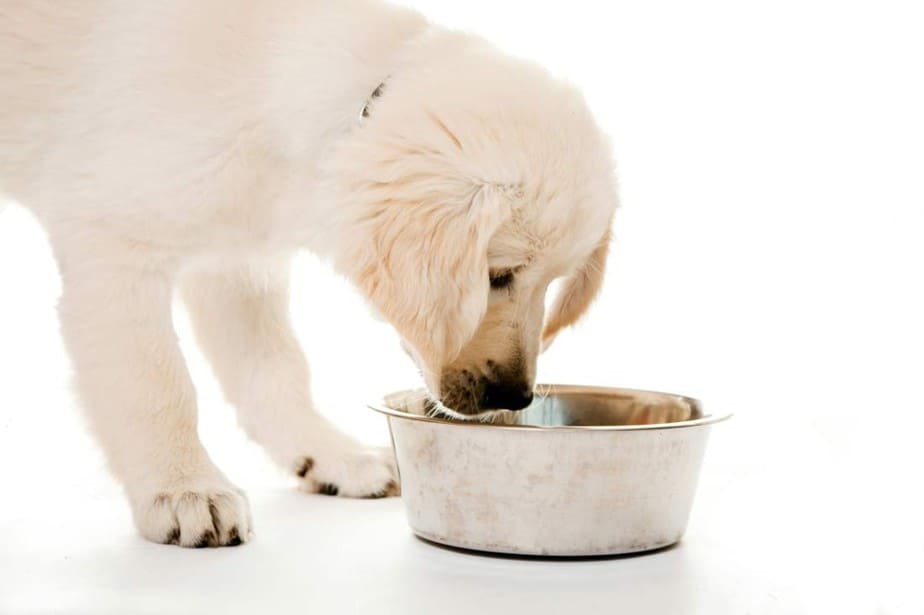
Puppy Won’t Eat Food but Eating Treats
If your puppy is eating their treats but not their kibble, then it’s a good idea to slow down their treat intake.
Also be sure to use puppy training treats that are small and won’t fill them up through training. We recommend True Acre Foods Chicken Recipe Mini-Training Rewards which are small enough not to overfill them.
TIP: Take note of the flavor of the treats that your puppy loves and look for a similar flavor of kibble.
It could also be because your puppy just likes it when you feed them from your hand. Try using their kibble as training treats. If they eat their kibble from your hand but not their bowl, then try changing their bowl or using the floor to feed them.
Puppy Only Eats Human Food
If your puppy has decided the only thing they’ll eat is human food then it’s because you or someone in the house is giving them human food. Now they know there’s an alternative to their food, they’ll want nothing less than the best.
A puppy can’t get all their nutrients from human scraps, however, and will need to be weaned off human food and put onto a balanced dog diet.
The best method to transfer them from human food to puppy food is to gradually swap your food for theirs. For instance, if they’ve taken a liking to mince-meat, put 50% in with 50% kibble. Then over the course of a week, slowly move more kibble into the bowl and less mince-meat until your puppy is only on their kibble.
Be sure to enforce no table scraps to the puppy among family members. Although it’s difficult not to give in to their cute little faces, it will only cause more issues when it comes time to feed them their kibble.
Puppy Not Eating or Drinking
If your puppy is suddenly not eating or drinking and is showing signs of lethargy then it’s best to get them to the vet.
Make sure you’re giving them enough exercise and then provide fresh water to them. If they drink and seem to be energetic and in good spirits, then it’s likely they just haven’t been thirsty.
If your puppy isn’t eating their kibble, and has been on a diet of wet food, then the food itself contains fluids and so they’ll require less water.
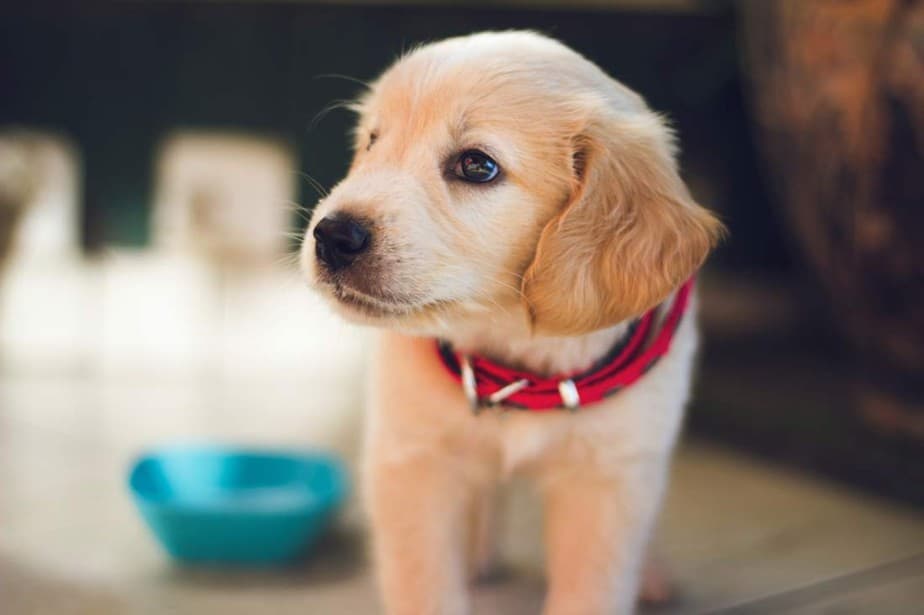
Puppy Not Eating and Sleeps a Lot
Puppies sleep between 18 and 20 hours in a day, so your puppy sleeping a lot is nothing to be concerned about. If they’re not eating at all and aren’t trying to get your human food, then you should take them to their vet for a check-up.
Watch for other symptoms of illness such as:
- Lethargy
- No interest in food
- Vomiting
- Diarrhea
When Can Puppies Eat Dry Food Without Water
By 8 to 10-weeks old puppies will have their full set of teeth. From this time it’s ok for them to eat dry kibble without soaking it into a soggy meal. We have more information on this topic here: Soaking Puppy Kibble: How, Why, and When to Stop
If they’re having issues adapting to their kibble without water, then try slowly transitioning by adding less and less water over a week or two.
Final Word
Be patient with your puppy and allow them time to adapt to eating kibble. If you’ve tried everything in this post and your puppy still won’t eat kibble, then it might just be they’ll have to eat wet food. They can still get a well-balanced, nutritious meal, even if it means you’ll have some of the down sides of a wet food diet.

